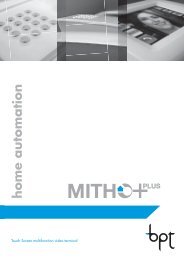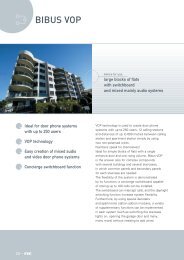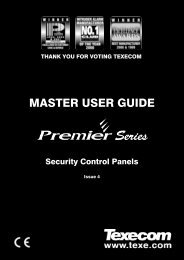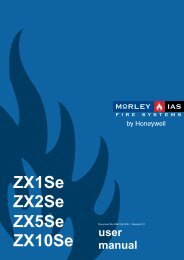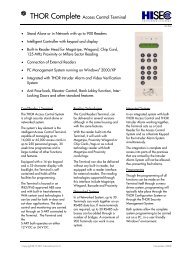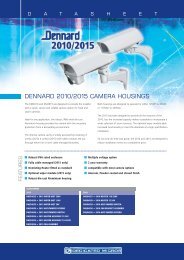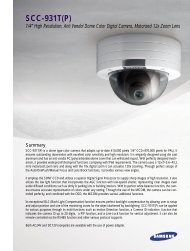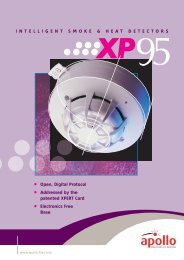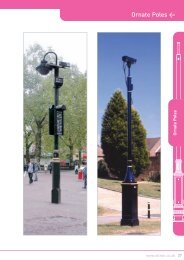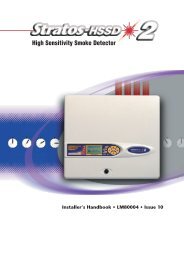Morley Fire Panels Installation Manual - Smiths Technical Systems
Morley Fire Panels Installation Manual - Smiths Technical Systems
Morley Fire Panels Installation Manual - Smiths Technical Systems
Create successful ePaper yourself
Turn your PDF publications into a flip-book with our unique Google optimized e-Paper software.
ZX <strong>Fire</strong> Alarm Control <strong>Panels</strong> MORLEY-IAS<br />
3.4.3 Detection Loops<br />
EN54<br />
!<br />
• The control panel supports analogue detectors with a digital, data transmission system. It<br />
provides power and communicates with the initiating devices over a two-wire circuit.<br />
EN54-2 13.7<br />
Maximum of 512<br />
sensors / MCPs<br />
per panel.<br />
• Depending on protocol, it is possible for up to 1000 addressable input<br />
points to be connected to the panel.<br />
• To comply with EN54-2 requirements, a maximum of 512 sensors /<br />
MCPs (input points) only should be connected to the control panel<br />
across all analogue detection loops (the limit for the ZX10Se is 1024 as<br />
it comprises two ZX5Se FACPs). This limit includes any conventional<br />
detectors / call points connected to the system via zone monitors.<br />
The detection circuit should be separated from other cable runs to minimize the risk of<br />
external interference. Under extremely noisy conditions, twisted pair wire is recommended<br />
to reduce interference.<br />
The Detection Loop Circuits are supervised and power limited.<br />
• Shielded cable should be used for all detection (SLC) circuits. It is important that the shield is<br />
always terminated to a good earth connection at both ends of the loop. Mineral insulated copper<br />
cable (MICC) is recommended for the best screening purposes. However, most of the established<br />
brands of fire-related, screened cables are suitable. Refer to Section 3.4.13 for a list of<br />
recommended cables.<br />
• The core size, length of wiring run and detection circuit loading will produce a voltage drop along<br />
the length of the cable. To determine if the installed loop driver can fully support the planned loop<br />
configuration, use the detector manufacturers’ calculations for voltage and capacitance.<br />
ALWAYS check that conductors of appropriate diameter are used so that the voltage at<br />
the detectors is within the detector manufacturer’s specification.<br />
The maximum permitted impedance for the SLC Loop is dependent on the loop driver<br />
card fitted and loop loading conditions. Please refer to the loop and battery calculator<br />
tool for specific recommendations.<br />
• The following table lists the maximum recommended cable loop lengths for each detection loop<br />
type. Wiring to external devices should follow the appropriate manufacturer’s instructions. Again,<br />
refer to the loop and battery calculator tool for site-specific recommendations.<br />
Loop Driver Maximum Loop Length<br />
MICC<br />
1.5mm<br />
18 AWG 16 AWG 14 AWG<br />
<strong>Morley</strong>-IAS 2 km 1 km 1.5 km 2 km<br />
System Sensor 2 km 1 km 1.5 km 2 km<br />
Apollo 2 km 1 km 1.5 km 2 km<br />
Hochiki 2 km 1 km 1.5 km 2 km<br />
Nittan 1 km 0.8km 1 km 1 km<br />
Table 3 – Maximum Loop Lengths<br />
• NOTE 1: Cable runs in excess of 2km are not recommended. Otherwise, cable capacitance<br />
(Max. 0.5µF per loop) and inductance may start to interfere with data transmission. For systems<br />
with Nittan detectors, cable runs should not exceed ½ km. Refer to the cable manufacturer’s<br />
quoted figures for maximum cable capacitance.<br />
• The SLC (detector) circuits should be installed as loops with or without isolator modules. The<br />
wiring details are as described below.<br />
<strong>Installation</strong> <strong>Manual</strong> Document No. 996-174-000-1, Revision: 01 Page 13



